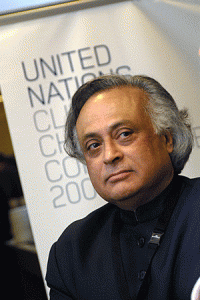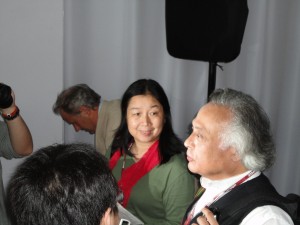Playing Smart
Yesterday Jai Ram delivered the following intervention at the high level segment. What was a little startling was that he mentioned that all economies should a legally binding commitment. After which he addressed a few journalists. “At this stage India’s strategy is to keep the door open, the door was being closed on us,” he told journalists.
With the conference closing tomorrow, India has objected to raising the issue so late in the day. It has also said that currently it is important to concentrate on the Kyoto protocol, which is the only legally binding treaty on climate change, but its future is uncertain since several countries want to abandon it. Speaking at an open meeting in Cancun, Ramesh told delegates that “all countries must take on binding commitments under appropriate legal form.”
This was not a part of the official speech copied below and sent some alarms across the plenary. The challenge here was understanding the language the minister had used- commitment versus agreement or treaty.
Does this mean that there is a techtonic shift in the stand of India ?
NO .
It just means we are playing smart with our words. With the language and perspective we are giving to legal forms of the decision at Cancun.
“We will honour these,” he said, noting that India was not ready to reflect these in an international agreement yet. The present discussion has also raised questions about what constitutes the “bindingness” of a treaty.
Although it could mean
Since on last Thursday the cabinet, approved a proposal mooted by Ramesh, altered the non-negotiable line and the cabinet decision now reads : India will not take any international legally binding agreement, at the moment. This has opened the window for Ramesh that while India would not take on commitments right now at Cancun, it could do so anytime in the future. Ramesh defended his move later though claiming several other countries in the developing nations’ block too were demanding that all countries take on binding targets.
In my opinion, this stems from the fact that India wants to be a part of the solution , it wants to be a face for breaking deadlocks .For Ramesh personally this is to get recognition back home and as per the Prime ministers mandate to make India a part of the solution.
Madame President:
Over sixty years ago, the Green Revolution in wheat was launched from Mexico with the development of new high-yielding varieties at CIMMYT. Today, Madame President, the word Sonora still resonates in my
country.
The time is now for us to launch an EverGreen Revolution from Mexico, a revolution that will trigger innovations in low-carbon technologies for energy, transport, agriculture and other areas. That is why yesterday, at the meeting chaired by the President of Mexico, I suggested that this Cancun meet take a decision to establish a CGIAR-like network of which CIMMYT is a part. I am pleased that the President warmly supported this idea which also received enthusiastic backing from Mexico’s Nobel Laureate in Chemistry Mario Molina. Last year, at Copenhagen I had spoken about India’s profound vulnerabilities to climate change and had described the actions being taken by us domestically and voluntarily to respond to this challenge in a proactive manner. Let me give you a quick update on what we have done
since then.
First, we have announced that we will reduce the emissions intensity of India’s GDP by 20-25% by the year 2020 on a 2005 reference level, through proactive policies. India’s Twelfth Five Year Plan, to be launched on April 1, 2012 will have, as one of its key pillars, a low-carbon growth strategy. Detailed work on this has already begun and is available in the public domain keeping in view our deepest commitment to transparency and accountability.
Second, we have taken firm steps to diversify our energy fuelmix. 20,000 Mw of solar power generating capacity will be set up by 2022 and the present share of nuclear power in our energy mix, which is 3% today, will be doubled over the next decade. A major market-based programme has been put in place to stimulate energy efficiency. We have imposed a clean energy cess on coal for funding R&D of clean energy technologies, even though coal will continue to play a key role in our future energy strategy. We have aggressively expanded the use of natural gas in our power production.
Third, we are pursuing aggressive strategies on forestry and coastal management. India’s 70 million hectares of forests have not only ecological, but also livelihood significance, as they support the livelihoods of 250 million people. We are launching an ambitious Green India Mission to increase the quality and quantity of forest cover in 10 million hectares of land. We have also launched a major new programme on coastal zone management to address the adaptation challenges facing over 300 million people in our country that live in vulnerable areas near
our coast.
Fourth, we have set up an elaborate Indian Network for Comprehensive Climate Change Assessment—an Indian IPCC as it were. This network of some 250 scientists and 120 research institutions has already published India’s greenhouse gas inventory for the year 2oo7. It has recently released a 4×4 assessment of climate change—impacts on four key sectors and four key regions of the country for the 2030s, a time frame for which decisive interventions can be made now. This network is soon going to be putting in place a programme for measuring, monitoring and modelling the impact of black carbon which could have climate change and public health impacts.
Fifth, we are actively engaging in partnerships with our neighbours and other countries to deal with climate change.India and Bangladesh will soon enter into an agreement to establish an Ecosystem Forum on the Sunderbans, which is the world’s largest riverine delta system. India, Nepal and China have started an ecosystem regeneration initiative in the holy Mount Kailash landscape. India has financed the establishment of a South Asian forestry centre in Bhutan and a coastal zone management centre in Maldives. We are talking to our AOSIS partners to launch a capacity building and technical assistance programme for scholars and experts from SIDS countries.
Madame President, India is constructively engaged in the process of international negotiations. You are aware that we have made detailed proposals on the MRV/ICA issue as well as on technology cooperation. I am happy that these proposals have evoked considerable support. These proposals have been made to stimulate discussion and arrive at a consensus on both these issues.
Ecological preservation and celebration of biodiversity is embedded in Indian culture in myriad ways. India will not only be amongst the fastest growing economies in the world as measured by GDP—Gross Domestic
Product—but will also be amongst the most responsible in ensuring a high rate of growth of the real GDP—Green Domestic Product. That is my solemn assurance to the world community today on behalf of the Government of India. Environmental stewardship demands responsive leadership. That is India’s calling. Thank you.




About the author
Leela Raina
Leela is a young climate activist with an undergraduate degree in Economics. She has pioneered youth involvement, awareness and movements across India through her work with the Indian Youth Climate Network. A policy enthusiast, Leela loves to research and get to the bottom of the problem to resolve it. She is currently the South Asian Focal Point for IYCN and believes in the capacity of the south asian youth to usher in and lead the way towards sustainable economic growth

